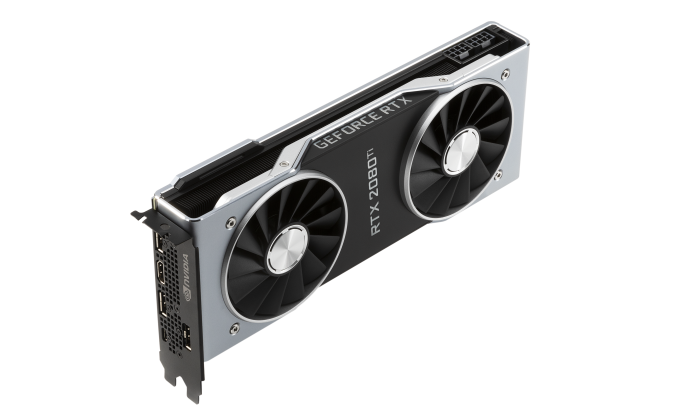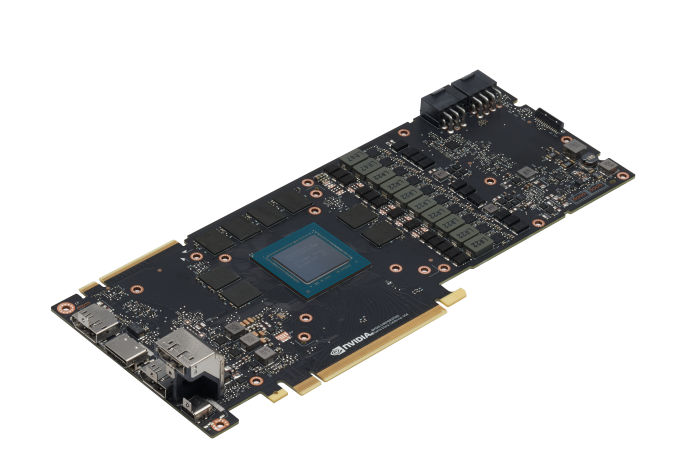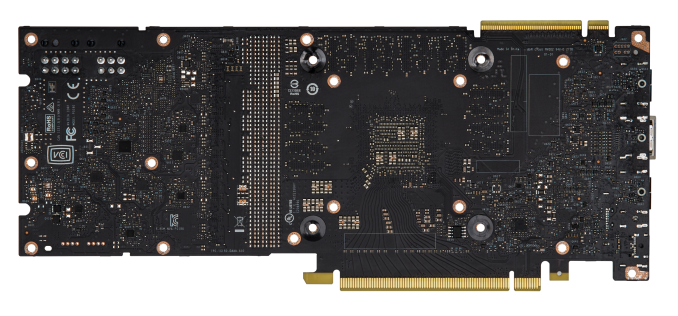The NVIDIA GeForce RTX 2080 Ti & RTX 2080 Founders Edition Review: Foundations For A Ray Traced Future
by Nate Oh on September 19, 2018 5:15 PM EST- Posted in
- GPUs
- Raytrace
- GeForce
- NVIDIA
- DirectX Raytracing
- Turing
- GeForce RTX
Meet The GeForce RTX 2080 Ti & RTX 2080 Founders Editions Cards
Moving onto the design of the cards, we've already mentioned the biggest change: a new open air cooler design. Along with the Founders Edition specification changes, the cards might be considered 'reference' in that they remain a first-party video card sold direct by NVIDIA, but strictly-speaking they are not because they no longer carry reference specifications.
Otherwise, NVIDIA's industrial design language prevails, and the RTX cards bring a sleek flattened aesthetic over the polygonal shroud of the 10 series. The silver shroud now encapsulates an integrated backplate, and in keeping with the presentation, the NVLink SLI connectors have a removable cover.
Internally, the dual 13-blade fans accompany a full-length vapor chamber and component baseplate, connected to a dual-slot aluminum finstack. Looking at improving efficiency and granular power control, the 260W RTX 2080 Ti Founders Edition features a 13-phase iMON DrMOS power subsystem with a dedicated 3-phase system for the 14 Gbps GDDR6, while the 225W RTX 2080 Founders Edition weighing in with 8-phases main and 2-phases memory.
As is typical with higher quality designs, NVIDIA is pushing overclocking, and for one that means a dual 8-pin PCIe power configuration for the 2080 Ti; on paper, this puts the maximum draw at 375W, though specifications-wise the TDP of the 2080 Ti Founders Edition against the 1080 Ti Founders Edition is only 10W higher. The RTX 2080 Founders Edition has the more drastic jump, however, with 8+6 pins and a 45W increase over the 1080's lone 8 pin and 180W TDP. Ultimately, it's a steady increase from the power-sipping GTX 980's 165W.
One of the more understated changes comes with the display outputs, which thanks to Turing's new display controller now features DisplayPort 1.4 and DSC support, the latter of which is part of the DP1.4 spec. The eye-catching addition is the VR-centric USB-C VirtualLink port, which also carries an associated 30W not included in the overall TDP.
Something to note is that this change in reference design, combined with the seemingly inherent low-volume nature of the Turing GPUs, cuts into an often overlooked but highly important aspect of GPU sales: big OEMs in the desktop and mobile space. Boutique system integrators will happily incorporate the pricier higher-end parts but from the OEM’s perspective, the GeForce RTX cards are not just priced into a new range beyond existing ones but also bringing higher TDPs and no longer equipped with blower-style coolers in its ‘reference’ implementation.
Given that OEMs often rely on the video card being fully self-exhausting because of a blower, it would certainly preclude a lot of drop-in replacements or upgrades – at least not without further testing. It would be hard to slot into the standard OEM product cycle at the necessary prices, not to mention the added difficulty in marketing. In that respect, there is definitely more to the GeForce RTX 20 series story, and it’s somewhat hard to see OEMs offering GeForce RTX cards. Or even the RT Cores themselves existing below the RTX 2070, just on basis of the raw performance needed for real time ray tracing effects at reasonable resolutions and playable framerates. So it will be very interesting to see how the rest of NVIDIA’s product stack unfolds.
















337 Comments
View All Comments
Fritzkier - Wednesday, September 19, 2018 - link
Blame both. Why the f you blame AMD for NVIDIA's own fault?And yes, AMD had competitive offering on mid-end, not on high end. But, that's before 7mm. Let's see what will we got on 7mm. 7mm will be released next year anyway, it's not that far off.
PopinFRESH007 - Wednesday, September 19, 2018 - link
Yep, lets wait for those 7mm processes. Those chips should only be the size of my computer with a couple hundred thousand transistors.Holliday75 - Friday, September 21, 2018 - link
Haha I was about to question your statement until I paid more attention to the process size he mentioned.Fritzkier - Saturday, September 22, 2018 - link
We seriously needs an edit button. Thanks autocorrect.Yojimbo - Wednesday, September 19, 2018 - link
So you are saying that if AMD were competitive then NVIDIA could never have implemented such major innovations in games technology... So, competition is bad?dagnamit - Thursday, September 20, 2018 - link
Competition can stifle innovation when the market is involved in race to see how efficiently they can leverage current technology. The consumer GPU market has been about the core count/core efficiency race for a very long time.Because Nvidia has a commanding lead in that department, they are able to add in other technology without falling behind AMD. In fact, they’ve been given the opportunity to start an entirely new market with ray-tracing tech.
There are a great many more companies developing ray-tracing hardware than rasterization focused hardware at the current moment. With Nvidia throwing their hat in now, it could mean other companies start to bring hardware solutions to the fore that don’t have a Radeon badge. It won’t be Red v. Green anymore, and that’s very exciting.
Spunjji - Friday, September 21, 2018 - link
Your Brave New World would involve someone else magically catching up with AMD and Nvidia's lead in conventional rasterization tech. Spoiler alert: nobody has in the past 2 decades and the best potential competition, Intel, isn't entering the fray until ~2020dagnamit - Sunday, September 23, 2018 - link
No. I’m saying that companies that specialize in ray-tracing technology may have an opportunity to get into the consumer discrete GPU market. They don’t need to catch up with anything.eva02langley - Thursday, September 20, 2018 - link
Not AMD fault if Nvidia is asking 1200$ US. Stop blaming AMD because you want to purchase Nvidia cards at better price, BLAME Nvidia!It is not AMD who force Ray Tracing on us. It is not AMD who want to provide gamework tools to sabotage the competition and gamers at the same time. It is not AMD charging us the G-sync tax. It is not AMD that screw gamers for the wallet of investors.
It is all Nvidia fault! Stop defending them! There is no excuses.
BurntMyBacon - Thursday, September 20, 2018 - link
I accept that nVidia's choices are their own and not the "fault" of any third party. On the other hand, nVidia is a business and their primary objective is to make money. Manufacturing GPUs with features and performance that customers find valuable is a tool to meet their objective. So while their decisions are their own responsibility, they are not unexpected. Competition from a third party with the same money making objective limits their ability to make money as they now have to provide at least the perception of more value to the customer. Previous generation hardware also limits their ability to make money as the relative increase in features and performance (and consequently value) are less than if the previous generation didn't exist. If the value isn't perceived to be high enough, customers won't upgrade from existing offerings. However, if nVidia simply stops offering previous generation hardware, new builds may still be a significant source of sales for those without an existing viable product.Long story short, since there is no viable competition from AMD or another third party to limit nVidia's prices, it falls to us as consumers to keep the prices in check through waiting or buying previous gen hardware. If, however, consumers in general decide these cards are worth the cost, then those who are discontent simply need to accept that they fit into a lower price category of the market than they previously did. It is unlikely that nVidia will bring prices back down without reason.
Note: I tend to believe that nVidia got a good idea of how much more the market was willing to pay for their product during the mining push. Though I don't like it (and won't pay for it), I can't really blame them for wanting the extra profits in their own coffers rather than letting it go to retailers.